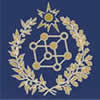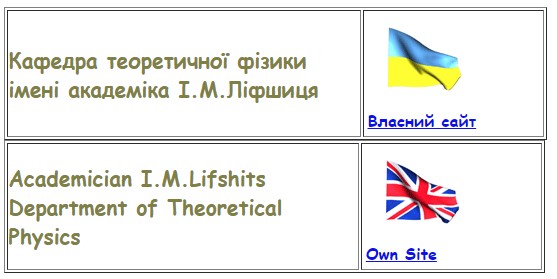Theoretical Physics Department staff lectures all courses of theoretical physics for BC and MS students at the Physical Faculty, advansed courses for for BC and MS students, who are studying at the Department of theoretical physics, also teaching Quantum mechanics third year students at the Faculty of radiophysics. All lecturers are well-known scientists, professors and associate professors of the V.N.Karazin Kharkiv National University, which belong to the scientific school of I.M.Lifshits.
Course of Theoretical Physics
Classical Mechanics
The aim of the course is to acquaint students with a mechanical picture of the universe, set out the basis for variational principles in the theory of motion of mechanical systems.
Students learning main stages of development of mechanical representations of the structure of the universe, studying the variational principles of mechanics and methods of integrating the equations of motion of mechanical systems.
Course catalogue for "Classical Mechanics"
- Newton's Equations of Motion
- Lagrange's Equations of Motion
- Intergation of The Equations of Motions
- Collisions and scattering of particles
- Small Oscillations
- Nonlinear Oscillations
- The Canonical Equations
- Motion of a rigid body
- Movement in a non-inertial reference frames
Electrodynamics
The aim of the course is to form the students' understanding on the properties of matter, to present a unified point of view the theory of the electromagnetic field in vacuum and in condensed matter..
Students study methods of classical field theory and the electrodynamics of continuous media, solve Maxwell's equations, calculate the electrodynamic characteristics of condensed matter.
Course catalogue for "Electrodynamics"
- Special Theory of Relativity and Relativistic Mechanics
- Charges in Electromagnetic Fields
- The Electromagnetic Fields Equations
- Constant Electromagnetic Fields in Vacuum
- Electromagnetic Waves
- The Field of Moving Charges
- Radiation of Electromagnnetic Waves
- Electromagnetic Fields Equations in Continuous Media
- Static Electric Fields in Continuous Media
- Static Magnetic Fields in Continuous Media
- Quasi-Static Electromagnetic Field
- The Propagation of Electromagnetic Waves in Continuous Media
Quantum Mechanics
The aim of the course is to form quantum representations of the students about the properties of microparticles, present the basic foundations and the principles of quantum mechanics, their application to the description of microsystems.
Students study the methods of nonrelativistic quantum theory, learn to solve the Schrödinger equation, obtain skills of using the principles of quantum mechanics.
Course catalogue for "Quantum Mechanics"
- Principles of Quantum Mechanics
- Schrödinger's equation
- Mathematical formalism of quantum mechanics
- Motion in a Centrally Symmetric Field
- The Quasi-classical Case
- The matrix form of quantum mechanics
- Perturbation Theory
- Spin and Identity of Particles
- Atomic Energy Levels
- Motion in a Magnetic Field
- Elastic Collisions
- The method of second quantization
- Interaction of light with matter
- Relativistic Quantum Mechanics
Thermodynamics and Statistical Physics
The aim of the course is to form students' statistical approach to studying the properties of macroscopic systems, present the course as a unified theory, which combines statistical physics and thermodynamics, classical and quantum statistics.
Students master the methods of statistical physics and thermodynamics calculations of the characteristics of macroscopic systems.
Course catalogue for "Thermodynamics and Statistical Physics"
- Basic Principles of Statistics
- Thermodynamic Values
- The Gibbs distribution
- Ideal macroscopic systems
- Ideal Fermi and Bose gases
- Non-ideal gases
- Fluctiations
- Phase transitions
- Solutions
- Surfaces
Physical Kinetics
The aim of the course is to form students' understanding of non-equilibrium states of macroscopic systems and physical processes in such systems.
Students learn the principles and methods of physical kinetics, how to calculate the kinetic characteristics of non-equilibrium systems.
Course catalogue for "Physical Kinetics "
- Non-equilibrium Thermodynamics
- Boltzmann Kinetic Equation
- The Kinetic Coefficients of Metals and Semiconductors
- The Density Matrix
- Galvanomagnetic and Thermomagnetic Phenomena in Metals
- Bogolyubov' Method
- Green' Function Method if Quantum Kinetics
- The theory of linear response
- Kubo Formula
- High-frequency Properties of Metals and Magnets
- The Kinetics of Phase Transformations
- The theory of strongly nonequilibrium processes
Advansed Courses Outline
-
Computer Calculation Methods
The purpose of the course is the study of intelligent systems of computer algebra (symbolic mathematics software systems).
-
Modern Computer Technology and Computer Methods
The content of course: visual programming, database elements of the Internet; computing system Mathematica, Maple; symbolic, numerical and graphical methods, modeling of physical phenomena, computer animation methods, computer experiments.
-
Modern Geometry and Tensor Analisis
-
Mechanics of continuous media
-
Gravitation Theory
-
Non-linear Physics
-
The Theory of Crystals
-
Solid State Physics
-
The Theory of Metals
-
The Theory of Magnetism
-
Quantum Statistics and Kinetics
-
The theory of many-particle systems
-
Mesoscopic physics
-
The Theory of Superconductivity
-
Quantum Field Theory
-
The theory of gauge fields
Geometry of Euclidean, Minkowski and Riemann spaces, group of transformations for these spaces. Tensor analysis in these spaces. The theory of manifolds, and layers.
The equation of motion of gases, liquids, solids, liquid crystals. Diffusion, thermal conductivity, sound waves in these media.
The motion of a particle in a gravitational field, Einstein's equation for the gravitational field, gravitational fields of bodies, three effects of the general theory of relativity, gravitational waves, the model and the evolution of the Universe, relativistic cosmology.
Nonlinear oscillations of mechanical systems. Qualitative, approximate and exact methods of investigations for mechanical systems. Nonlinear waves in elastic media and magnetically ordered systems. Solitons. Vortices.
The geometry of the crystal lattice, atoms' dynamics in the crystall lattice, the thermodynamics of crystals and their thermal conductivity, lattice defects, light and neutron scattering in crystals.
Geometry of crystal lattice, Bloch theorem, one-electron approximation for electron energy spectrum in periodic crystal field, grounds of zone theory, classifications for chemical bonds, statistical mechanics of conductive electrons, behaviour in constant and alternative electrical and magnetic fields, interactions electrons with lattice oscillations are considered.
An electron in a periodic field, band theory, the dynamics of conduction electrons in electric and magnetic fields, electron scattering, statistical mechanics of the conduction electrons, the scattering of electrons, the kinetics of electrons and phonons, high-frequency properties of metals, the absorption of sound in them.
Foundations of modern quantum theory of magnetism as one of the examples in the theory of strongly correlated electron systems. The basic models of strong magnetism: Ising model, Heisenberg model, Hubbard model, s-d-model. Exact and approximate methods for constructing the energy spectrum and the thermodynamics of the isotropic and anisotropic Heisenberg model for various dimensions of the spin variable and the magnetic sublattice.
The methods of the modern theory of condensed matter: second quantization, the statistical operator, the temperature Green's function, functional methods, the method of Keldysh.
Functional methods in the theory of classical systems. Quantum Green's function. Fermi-liquid theory. Electron-electron, electron-phonon, electron-impurity interactions in metals and path integrals. The electron gas in a magnetic field. Interacting bosons and superfluidity.
Quantum theory of an ensemble of small disordered systems, which are in the same macrostate, but differ in implementation of the disorder. Nanophysics.
Macroscopic and microscopic theory of superconductivity in metals, Ginzburg-Landau theory, two kinds of superconductors, the kinetics of superconductors superconductors in the high-frequency field, the Josephson effect, Gor'kov and Eliashberg methods in the theory of superconductivity, high-temperature superconductivity.
The theory of quantum fields, mainly electromagnetic. The general properties of relativistic wave equations, the Dirac equation for the electron and the Maxwell equations for electromagnetic fields. The canonical quantization of fields. Interaction of electrons and photons. Feynman rules for calculating the probability of physical processes.
The principle of gauge invariance. Yang-Mills fields. Spontaneous symmetry breaking, the Higgs mechanism, the Weinberg-Salam model as an example of renormalizable theories of electroweak vzaimodeysstvy leptons, a generalization of this model to the physics of hadrons.


